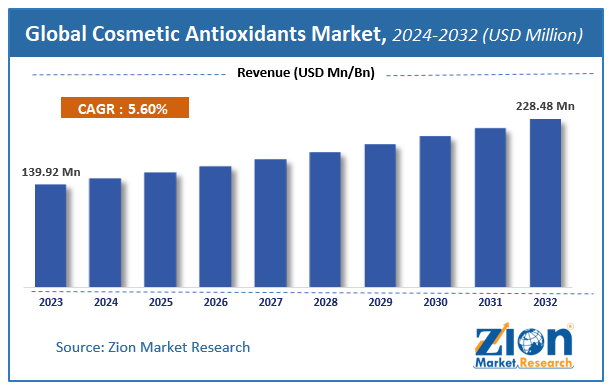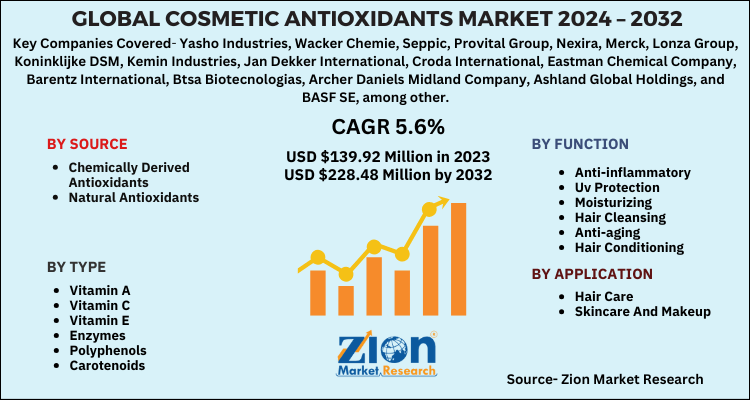Cosmetic Antioxidants Market Size & Share Report, Growth, Trends, 2032

Cosmetic Antioxidants Market - by Type (Vitamin A, Vitamin C, Vitamin E, Enzymes, Polyphenols, and Carotenoids), Source (Chemically Derived Antioxidants, and Natural Antioxidants), and Function (Anti-Inflammatory, UV Protection, Moisturizing, Hair Cleansing, Anti-Aging, Hair Conditioning, and Others) Application (Haircare, Skincare, And Makeup): Global Industry Perspective, Comprehensive Analysis and Forecast 2024 - 2032
| Market Size in 2023 | Market Forecast in 2032 | CAGR (in %) | Base Year |
|---|---|---|---|
| USD 139.92 Million | USD 228.48 Million | 5.6% | 2023 |
Cosmetic Antioxidants Market Insights
Zion Market Research has published a report on the global Cosmetic Antioxidants Market, estimating its value at USD 139.92 Million in 2023, with projections indicating that it will reach USD 228.48 Million by 2032. The market is expected to expand at a compound annual growth rate (CAGR) of 5.6% over the forecast period 2024-2032. The report explores the factors fueling market growth, the hitches that could hamper this expansion, and the opportunities that may arise in the Cosmetic Antioxidants industry. Additionally, it offers a detailed analysis of how these elements will affect market demand dynamics and market performance throughout the forecast period.
Global Cosmetic Antioxidants Market: Overview
Cosmetic antioxidants are natural substances that are made of vitamins and minerals. These help in fighting against free radicals that can cause harm to DNA, proteins, and lipids. The damaged skin cells lead to aging along with wrinkles, dry skin, dark circles. It also affects skin flexibility. Cosmetic antioxidants are helpful to humans in two ways—they help in avoiding degradation of natural substances, including proteins, sugars, and lipids in cosmetic items and help in slowing down the process of aging. The demand and popularity of the cosmetic antioxidants market on a global scale can be attributed to the increased use of hair care products to safeguard one’s mane from the adverse effects of environmental pollution.
Global Cosmetic Antioxidants Market: Growth Factors
The major growth drivers in the global cosmetic antioxidants market are rapidly increasing the population of aged people globally, changing the lifestyle of people across the globe, and the growing disposable income of the middle-class people. The growing demand for skincare items, increasing adoption of beauty care and personal care products, especially in emerging economies, such as India and China, and rising demand for hair conditioning products for safeguarding one’s mane from the harmful effects of pollution are among other factors that are fuelling the demand for the cosmetic antioxidants market across the world.
However, the penetration of advanced medical technologies in various developed countries, the high-priced natural antioxidants, and the rising concerns of synthetic antioxidants might limit the cosmetic antioxidants market on a global scale in the near future.
Global Cosmetic Antioxidants Market: Segmentation
The global cosmetic antioxidants market is classified into type, source, function, and application and region. All the segments have been analyzed based on present and future trends and the market is estimated from 2024 to 2032.
By type, the market for cosmetic antioxidants is divided into Vitamin A, Vitamin C, Vitamin E, enzymes, polyphenols, and carotenoids.
In terms of source, this market is bifurcated into chemically derived antioxidants and natural antioxidants.
On the basis of function, this global market includes anti-inflammatory, UV protection, moisturizing, hair cleansing, anti-aging, hair conditioning, and others.
Based on application, the cosmetic antioxidants market is fragmented into hair care, skincare, and makeup.
The skincare segment is likely to dominate the market, due to growing consciousness regarding physical appearance among the global population.
Cosmetic Antioxidants Market: Report Scope
| Report Attributes | Report Details |
|---|---|
| Report Name | Cosmetic Antioxidants Market |
| Market Size in 2023 | USD 139.92 Million |
| Market Forecast in 2032 | USD 228.48 Million |
| Growth Rate | CAGR of 5.6% |
| Number of Pages | 110 |
| Key Companies Covered | Yasho Industries, Wacker Chemie, Seppic, Provital Group, Nexira, Merck, Lonza Group, Koninklijke DSM, Kemin Industries, Jan Dekker International, Croda International, Eastman Chemical Company, Barentz International, Btsa Biotecnologias, Archer Daniels Midland Company, Ashland Global Holdings, and BASF SE, among others |
| Segments Covered | By Type, By Source, By Function, By Application And By Region |
| Regions Covered | North America, Europe, Asia Pacific (APAC), Latin America, Middle East, and Africa (MEA) |
| Base Year | 2023 |
| Historical Year | 2018 to 2022 |
| Forecast Year | 2024 - 2032 |
| Customization Scope | Avail customized purchase options to meet your exact research needs. Request For Customization |
Global Cosmetic Antioxidants Market: Regional Analysis
The global cosmetic antioxidants market is classified into Europe, North America, the Middle East and Africa, Latin America, and Asia Pacific. North America and Europe are developed markets for cosmetic antioxidants and are likely to show good growth in the upcoming years. This growth can be attributed to the increasing demand for best quality natural ingredients in cosmetic products with minimum side effects, which, in turn, is driving the market for cosmetic items with natural antioxidants. In the Asia Pacific region, China, Japan, and India are major markets for cosmetic antioxidants and are likely to be in the future. This is due to the increasing consumer spending on cosmetic items and bettering economies of emerging economies in the region.
Global Cosmetic Antioxidants Market: Competitive Players
Some of the most important market players in the global cosmetic antioxidants market include-
- Yasho Industries
- Wacker Chemie
- Seppic
- Provital Group
- Nexira
- Merck
- Lonza Group
- Koninklijke DSM
- Kemin Industries
- Jan Dekker International
- Croda International
- Eastman Chemical Company
- Barentz International
- Btsa Biotecnologias
- Archer Daniels Midland Company
- Ashland Global Holdings
- BASF SE
- Among others
This report segments the Global Cosmetic Antioxidants Market as follows:
Global Cosmetic Antioxidants Market: Type Analysis
- Vitamin A
- Vitamin C
- Vitamin E
- Enzymes
- Polyphenols
- Carotenoids
Global Cosmetic Antioxidants Market: Source Analysis
- Chemically Derived Antioxidants
- Natural Antioxidants
Global Cosmetic Antioxidants Market: Function Analysis
- Anti-inflammatory
- Uv Protection
- Moisturizing
- Hair Cleansing
- Anti-aging
- Hair Conditioning And Others
Global Cosmetic Antioxidants Market: Application Analysis
- Hair Care
- Skincare And Makeup
Cosmetic Antioxidants Market: Regional Segment Analysis
- North America
- The U.S.
- Canada
- Europe
- France
- The UK
- Spain
- Germany
- Italy
- Rest of Europe
- Asia Pacific
- China
- Japan
- India
- South Korea
- Southeast Asia
- Rest of Asia Pacific
- Latin America
- Brazil
- Mexico
- Rest of Latin America
- Middle East & Africa
- GCC
- South Africa
- Rest of Middle East & Africa
Table Of Content
Methodology
FrequentlyAsked Questions
Rising productivity growth for anti-aging cosmetics and personal care products and an increasing ageing population, developing countries, are key factors driving the global market for cosmetic antioxidants. The growth of the global market is also being fuelled by growing perception of cosmetic products coupled with increasing disposable cash.
According to Zion Market Research, global demand for cosmetic antioxidants market is expected to generate revenue of around USD 228.48 Million by end of 2032, growing at a CAGR of around 5.6% between 2024 and 2032.
The Asia Pacific cosmetic antioxidants market is projected to hold the largest share globally in the future. Growing demand for natural ingredients in cosmetics especially in China and India is expected to propel the demand.
Some main participants of the Cosmetic Antioxidants market are Yasho Industries, Wacker Chemie, Seppic, Provital Group, Nexira, Merck, Lonza Group, Koninklijke DSM, Kemin Industries, Jan Dekker International, Croda International, Eastman Chemical Company, Barentz International, Btsa Biotecnologias, Archer Daniels Midland Company, Ashland Global Holdings, and BASF SE, among others.
RelatedNews
HappyClients
Zion Market Research
Tel: +1 (302) 444-0166
USA/Canada Toll Free No.+1 (855) 465-4651
3rd Floor,
Mrunal Paradise, Opp Maharaja Hotel,
Pimple Gurav, Pune 411061,
Maharashtra, India
Phone No +91 7768 006 007, +91 7768 006 008
US OFFICE NO +1 (302) 444-0166
US/CAN TOLL FREE +1 (855) 465-4651
Email: sales@zionmarketresearch.com
We have secured system to process your transaction.
Our support available to help you 24 hours a day, five days a week.
Monday - Friday: 9AM - 6PM
Saturday - Sunday: Closed






